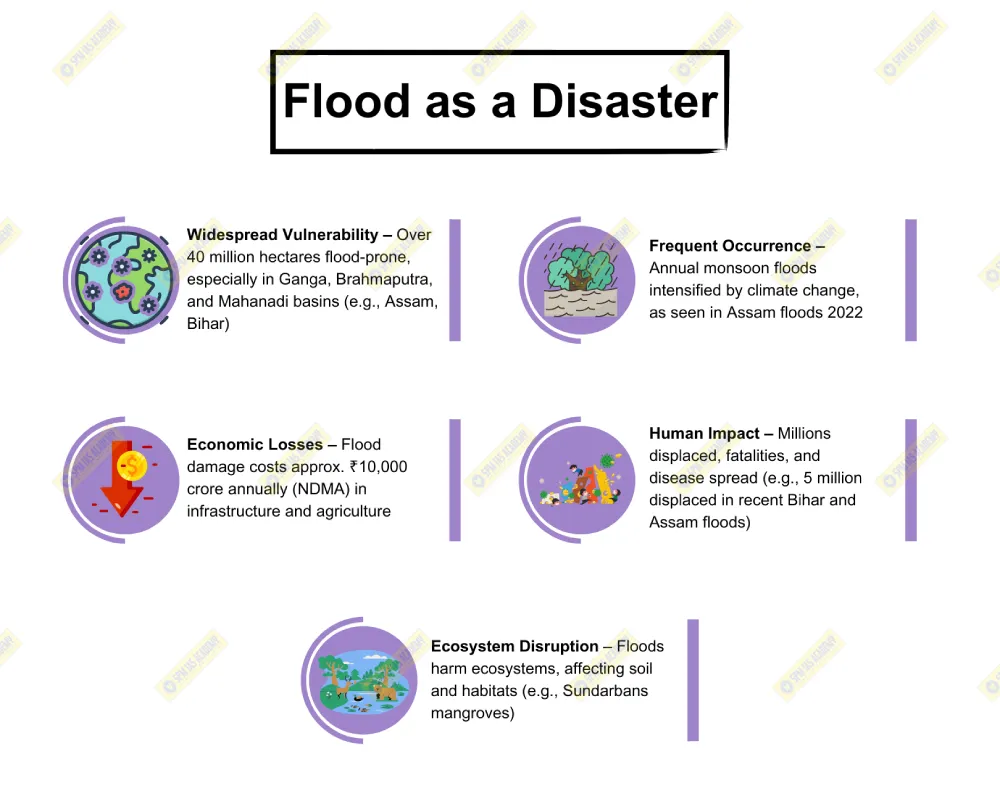India, with vast flood-prone areas across river basins like the Brahmaputra, Ganga, and Mahanadi, faces annual disruptions to lives, infrastructure, and agriculture due to flooding. The Central Water Commission (CWC) estimates that over 40 million hectares are vulnerable, and with climate change, the frequency and intensity of floods are rising. Effective flood management now requires a dual approach: structural measures like dams and embankments, alongside non-structural measures such as early warning systems, zoning laws, and community awareness. This integrated strategy is essential for minimizing economic losses and protecting flood-prone communities.

Structural Mitigation Measures
Structural measures involve physical infrastructure and engineering solutions to control or reduce flood risks. Key examples include:
1. Dams and Reservoirs
Dams like the Bhakra Nangal Dam on the Sutlej River are built to control water flow, reduce downstream flooding, and store excess water during heavy rainfall. CWC (Central Water Commission) reports suggest that India’s dams have prevented massive downstream flooding impacts in high-risk zones.
2. Embankments and Levees
These barriers protect urban and agricultural areas along riverbanks from floodwaters. Brahmaputra embankments in Assam, for example, have been a vital defense for flood-prone areas. The Rashtriya Barh Ayog recommended strengthening and maintaining embankments for long-term protection.
3. Flood Control Channels and Diversions
Channels divert excess water away from flood-prone zones. For instance, the Kosi Barrage in Bihar diverts overflow to control flooding in the Kosi River basin.
4. Stormwater Drainage Systems
Improved urban drainage infrastructure in cities like Mumbai helps channel rainwater to prevent urban flooding. National Urban Flooding Commission advises upgrading drainage systems to handle increasing urbanization and climate change impacts.
5. Wetland Restoration
Natural wetlands like those in the Sunderbans act as buffers, absorbing excess water. The Wetlands (Conservation and Management) Rules, 2017 promote wetland restoration to reduce flood impacts in vulnerable areas.
Non-Structural Mitigation Measures
Non-structural measures include policies, regulations, and community initiatives designed to enhance flood preparedness and resilience without physical infrastructure.
1. Flood Forecasting and Early Warning Systems
The Central Water Commission (CWC) and IMD have enhanced forecasting systems with Doppler radars and satellite data to provide timely flood alerts. The National Disaster Management Authority (NDMA) supports these initiatives, improving early response.
2. Land Use Zoning and Floodplain Management
The Gopalakrishnan Committee recommended zoning regulations that restrict construction in flood-prone areas, reducing risk to life and property. For instance, Chennai has adopted stricter zoning in its urban planning.
3. Public Awareness and Community Preparedness
Campaigns under the National Disaster Management Plan educate communities on flood safety, emergency responses, and evacuation routes, empowering communities to act quickly during floods.
4. Insurance and Financial Incentives
Flood insurance, supported by schemes like the Pradhan Mantri Fasal Bima Yojana (PMFBY) for crop insurance, helps communities recover from financial losses post-flood.
5. Integrated River Basin Management
Encouraged by the NITI Aayog and the National Water Policy, this approach involves coordinated management of water resources across states to prevent floods through sustainable practices.
The integration of structural and non-structural measures in flood management enables India to reduce flood risks effectively while building long-term resilience. Initiatives like improved early warning systems, infrastructure upgrades, and public awareness campaigns are essential to protect lives, property, and livelihoods from the growing threats posed by climate change-induced floods.











